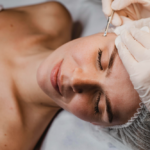Table of Contents:
- Introduction to Dermal Fillers
- How Do Dermal Fillers Work?
- Common Types of Dermal Fillers
- Benefits of Using Dermal Fillers
- Potential Risks and Considerations
- How to Choose the Right Practitioner
- Maintaining Results Over Time
- Future Trends in Dermal Fillers
Introduction to Dermal Fillers
In the evolving world of cosmetic enhancements, dermal fillers have emerged as a modern marvel at the intersection of science and artistry. These minimally invasive treatments cater to anyone looking to regain or enhance their youthful radiance without complex surgeries. From restoring volume in sagging cheeks to refining the plumpness of lips, procedures like lip fillers are now commonplace in beauty routines. The appeal lies not only in the immediate transformation but also in the procedure’s simplicity and safety.
With the growing public interest, understanding the nuances behind dermal fillers becomes essential. This comprehensive guide dissects everything from how fillers work to selecting the right practitioner, ensuring you make informed decisions on your beauty journey. As cosmetic technology advances, these enhancements become more integrated with holistic self-care practices, providing both external and internal confidence and satisfaction.
How Do Dermal Fillers Work?
The science of dermal fillers is grounded in their ability to replicate substances naturally found within the skin. Primarily using hyaluronic acid, a compound renowned for its efficacy in retaining moisture and promoting skin hydration, fillers rejuvenate aging skin by restoring lost volume and smoothness. When injected strategically into the dermal layers, they act as a cushioning support below the skin’s surface, smoothing lines and enhancing facial contours.
Techniques such as microneedling often complement these filler treatments. By promoting collagen production, such techniques can further improve the overall texture and elasticity of the skin, creating a synergistic effect when used in tandem. Understanding the interplay between treatments is crucial for maximizing results and achieving a natural, youthful appearance.
Common Types of Dermal Fillers
Navigating the world of dermal fillers involves understanding the different types available, each designed to address specific aesthetic concerns. The most versatile are Hyaluronic Acid Fillers, famed for their natural compatibility with the skin’s hydration processes. These fillers are perfect for treating everything from fine lines and wrinkles to adding volume in areas like the lips and cheeks.
Another notable type is Calcium Hydroxylapatite, a denser filler commonly used for more substantial facial contouring and deeper wrinkles. This filler adds volume and boosts the skin’s collagen production for prolonged youthfulness. Meanwhile, Polylactic Acid works as a collagen stimulator, helping the body produce its structural proteins for a gradual, lasting rejuvenation.
These various fillers are increasingly popular due to their efficacy and favorable safety profiles, making them a go-to choice for millions seeking aesthetic enhancements.
Benefits of Using Dermal Fillers
Dermal fillers offer various benefits that appeal to both the aesthetic desires and practical considerations of individuals seeking cosmetic enhancements. One of their most appealing features is the immediacy of the results. Unlike surgical options that require extensive recovery time, fillers offer a quicker path back to normalcy, often allowing individuals to resume their regular activities almost immediately after the procedure.
Beyond the captivating visual transformations, dermal fillers play a significant role in enhancing one’s self-esteem. Many users report renewed confidence post-treatment, noting improvements in their appearance, social interactions, and professional lives. These benefits transcend the physical, offering a holistic uplift in well-being and confidence.
Potential Risks and Considerations
While dermal fillers boast a strong safety record, it’s crucial to approach such treatments with informed caution. Common side effects include temporary redness, swelling, and bruising at the injection sites. Although rare, more serious adverse effects, such as infections or allergic reactions, are also potential. These risks underscore the importance of selecting the right practitioner and understanding the used products.
Ensuring patient safety involves more than choosing high-quality fillers; it requires a thorough understanding of the patient’s medical history and aesthetic goals. This holistic approach helps craft a treatment plan that minimizes risks and aligns expectations with likely outcomes.
How to Choose the Right Practitioner
Selecting a qualified and experienced practitioner is pivotal to ensuring safe and successful filler treatments. Look for professionals with verifiable credentials and a reputable track record in performing cosmetic procedures. Take the time to read patient reviews and seek recommendations from trusted individuals who have undergone similar treatments.
A thorough consultation should be a non-negotiable part of your process. It provides a platform for discussing your goals, concerns, and options customized to your needs. This conversation is a foundation for building trust and ensuring that the treatment plan aligns with patient expectations.
Maintaining Results Over Time
Incorporating lifestyle and skincare routines is advisable to maximize the longevity of dermal filler results. Regular moisturizing, sunscreen application, and avoiding prolonged sun exposure can protect the skin and extend the life of fillers. Implementing a skincare regimen focusing on collagen support can keep your skin looking its best between sessions.
Periodic touch-up treatments are vital to preserving the enhancements over the long term. By maintaining open communication with your practitioner, you can develop a timeline for follow-up sessions that fit seamlessly into your lifestyle, ensuring consistent and satisfying results.
Future Trends in Dermal Fillers
The dermal filler industry is poised for exciting developments, with innovations aimed at improving the longevity and effectiveness of treatments. As consumer demand shifts towards more natural-looking results, manufacturers are focused on creating products that more closely mimic the skin’s biology, offering longer-lasting and more harmonious outcomes.
Furthermore, advancements in techniques and technologies promise to make these treatments even more accessible and personalized. As understanding of facial anatomy deepens, practitioners are better equipped to deliver results that cater to individual needs and preferences, enhancing the nuanced artistry of cosmetic enhancements.







